Two very different programs showed Josef Haydn in different lights last week. And then turned around and delivered stunning  modern works. At an April 4 program featuring Thomas Adès’ 2005 Violin Concerto (Concentric Paths), Leila Josefowicz wowed a packed Davies Symphony Hall.
modern works. At an April 4 program featuring Thomas Adès’ 2005 Violin Concerto (Concentric Paths), Leila Josefowicz wowed a packed Davies Symphony Hall.
The San Francisco Symphony warmed up with Haydn’s Symphony No. 52 in C Minor, the epitome of Haydn’s sturm und drang phase. The symphony musicians were more than competent but less than inspired. They hardly seemed to look at conductor James Gaffigan, who was practically dancing on the podium. Each stormy phrase of “sturm” was followed by lilting complacence, a comradely reassurance. Lovely proportion, and boring as…18th-century Austrian suburbia.
Josefowicz arrived in a floor length affair, arched against the tilt of very high heels. The orchestra abruptly woke up for Adès’ high-energy piece with its bizarre textures. Very tight unison blasts showed their concentration. Josefowicz’ 1724 Guarneri del Gesu violin was often drowned by other strings or appeared in the highest register, bobbing in waves of shrill flute and strained oboe.
From beginning to end she never paused for a beat’s rest, a display of endurance that the writing demands and that few will equal.
Sudden tuba blasts would step on her violin runs, which I slowly realized was intentional. I mean, how many times could a symphony tuba player miscount bars? Not too likely, right? Adès seems to inherit his humor from the sly Leos Janacek.
The slower center of the work, Paths, replaced high arpeggios with nasal slides. Passages descended over and over, and kettledrum and trombone joined the violin for an unlikely trio. The soloist begins an arduous journey back up, then ends in low growling.
Adès uses long sweet passages, though they are not so much passages as parts of transformations: his motifs don’t quite “end” so much as “move on.”
The final part, Rounds, is fast and as relentless as Martinu, with frustrated flutters and hard-edged coloration.
And the other Haydn?

The following afternoon, Sunday, April 5, I was fortunate enough to hear the St. Lawrence String Quartet at Stanford. First violinist Geoff Nuttall led an impassioned reading of Haydn’s String Quartet in E-flat Major, and it was absolutely molten. Written for his good friend Luigi Tomasini, Haydn pulled out the stops to showcase the violin.
I knew that Haydn was one of the greats, but after Saturday night I was ready for my snooze alarm. Nuttall gave the simple melodies fresh life with golden notes, expressive phrasing and edginess. I felt that I was listening to Cecilia Bartoli sing basic Italian art songs—simple and sublime and the essence of timeless music.
The foursome followed that with a John Adams premiere, String Quartet, which he wrote for these performers, and the local legend was there in person to hear his piece.
Nuttall brought him up on stage, and Adams commented on the work. “I was so happy not to be saying it’s about an atomic bomb,” he joked, referring to his opera, Dr. Atomic. “It’s just music. Leave me alone.” After describing the structure—“the scherzando is jazzy. Then the finale gets virtually hysterical”—he gave us an insight into successful work, the huge effort that goes into it. “They played it ten times, and I sat for two and a half hours fine-tuning this morning.”
And the music: dense trills, big pizzicati, muscular cello. Like Beethoven’s, Adams’ motifs were minimal, but what he achieves is awesome. Toward the end I felt as if the performers had drawn me out into choppy seas of sixteenth notes in a small boat. Each performer’s musical material surfaced as we lurched up and down.
The quartet finished the program with a joyous Dvorak quartet, pure icing on a glorious afternoon.
The St. Lawrence String Quartet return to Stanford Lively Arts for three programs next year, with details at http://livelyarts.stanford.edu.
—Adam Broner
This article originally appeared in the Piedmont Post
Photo of St. Lawrence String quartet by Marco Borggreve
